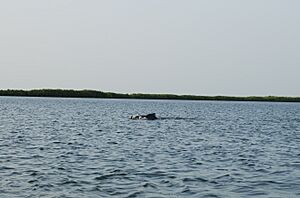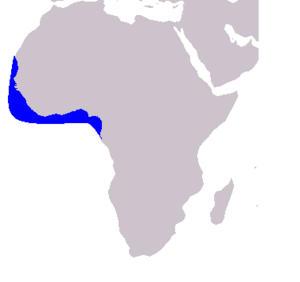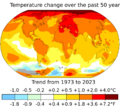Atlantic humpback dolphin facts for kids
Quick facts for kids Atlantic humpback dolphin |
|
|---|---|
 |
|
 |
|
| Conservation status | |
| Scientific classification | |
| Genus: |
Sousa
|
| Species: |
teuszii
|
 |
|
| Range of Atlantic humpback dolphin | |
| Synonyms | |
|
Sotalia teuszii Kükenthal, 1892 |
|
The Atlantic humpback dolphin (Sousa teuszii) is a special type of humpback dolphin. You can find it living along the coasts of West Africa.
Sadly, experts from the IUCN say this dolphin is critically endangered. This means it's at a very high risk of disappearing forever.
Contents
About the Atlantic Humpback Dolphin
This dolphin looks different from other humpback dolphins, like those in the Indo-Pacific. It has a unique skin color and body shape. Atlantic humpback dolphins are usually gray or white. Other humpback dolphins might have pink spots.
Some male Atlantic humpbacks have clear humps under their dorsal fins. They also have strong bodies and a well-shaped snout. Their backs and sides are often slate gray, fading to light gray underneath. Their dorsal fin is small and triangular, sitting on a noticeable hump.
What Makes Them Different?
Atlantic humpback dolphins also have fewer teeth than other species. They usually have about 30 teeth per row. Other humpback dolphins might have 33 to 37 teeth. Their skulls are also shorter and wider.
When they are born, these dolphins weigh about 14 kg (31 lb) and are 100 cm (39 in) long. A fully grown male can weigh up to 280 kg (620 lb) and be around 2.8 m (9 ft 2 in) long. That's almost as long as a small car!
Where They Live and What They Eat
You can find these dolphins along the tropical and subtropical west coast of Africa. This area stretches from Western Sahara down to Angola. They are not seen very often and appear in different spots across these waters.
They mostly live in shallow coastal areas and river mouths. These waters are usually less than 20 m (66 ft) deep. This is called the Neritic zone, which means it's the part of the ocean over the continental shelf.
How They Behave
Atlantic humpback dolphins are known to be shy. They don't often swim at the front of boats (called bow-riding). You also rarely see them jumping high out of the water. Sometimes, they might leap, peek their heads out (spy-hop), or slap the water with their tails.
These dolphins prefer to stay away from noisy boat engines. When you see them, they are probably traveling or looking for food. They can hunt alone or work together in groups. These groups usually have 1 to 8 dolphins. But sometimes, larger groups of 20 to 40 have been seen. They swim at an average speed of about 4 km/h (2.5 mph) when traveling.
What's on the Menu?
These dolphins usually hunt close to shore in shallow waters. They often feed in the surf zone, where waves break. They seem to eat mostly schooling fish, like mullet. But they also eat other coastal fish and crustaceans (like crabs or shrimp). What they eat depends on where they live and what food is available.
They tend to feed in small bays and calm waters behind reefs. They also like areas near dry river mouths. When they travel, they mostly stick to exposed coastlines.
Dolphins and People
Atlantic humpback dolphins are known to work with Mauritanian Imraguen fishermen. The dolphins help by herding fish towards the shore and into the fishermen's nets. This is a special way they interact!
However, human activities are also the biggest danger to these dolphins. Getting caught by accident in fishing nets is their greatest threat. Other dangers include being hunted, losing their homes, and pollution in the ocean. Overfishing also means less food for them. Noise from human activities and climate change also hurt them.
Why They Are in Danger
Losing their habitat and having it become polluted are major reasons why Atlantic humpback dolphin numbers are dropping. Humans are building more communities along the coast. This pollutes the oceans and harms marine animals.
Other Dangers
- Overfishing: When too many fish are caught, there isn't enough food left for the dolphins. This means they don't get enough to eat.
- Pollution: Things like oil spills, untreated sewage, and farm runoff pollute the ocean. These can cause harmful bacteria to grow. Toxins from these bacteria can be very dangerous for critically endangered species like these dolphins.
- Noise Pollution: Loud noises from coastal building and shipping can harm the dolphins' hearing. This is called anthropogenic sound.
- Climate Change: The places Atlantic humpbacks live depend on water temperature and where their food is. Climate change causes water temperatures to change. This forces the dolphins to adapt to new conditions.
Protecting the Dolphins
The Atlantic Humpback dolphin is critically endangered. This is because they live in a small area and have specific habitat needs. Their population is small, and human threats continue to harm them.
Coastal development in Africa is growing. This will keep disturbing these shy dolphins, directly or indirectly. These dolphins have already faced challenges from climate change. They have adapted to some changes caused by humans. They don't live in cold, deep ocean waters because of rising world temperatures. The only places left for them are shallow, warm waters. If global temperatures keep rising, they might not have any suitable homes left.
What Can Be Done?
- Stronger Laws: Enforcing laws about bycatch (animals caught by accident) and creating marine protected areas can help. For example, laws that say fishing nets can't be cast too close to shore would help dolphins survive.
- Education: Teaching communities about the threats to dolphins is important. Public awareness campaigns and training can help people learn about marine life conservation.
- Research: Scientists are learning more about Atlantic Humpbacks. They are looking into how human activities can cause less harm to the species.
See also
- List of cetaceans
Images for kids




